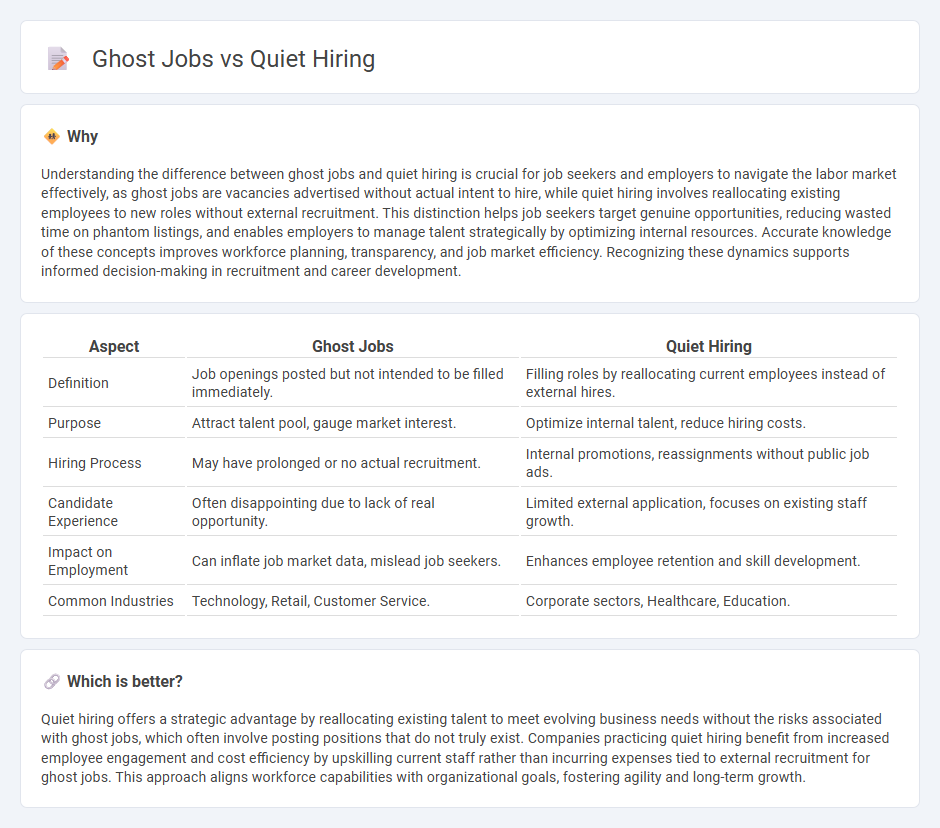
Ghost jobs refer to job postings that appear open but do not result in actual hiring, often used by companies to gauge market interest or build talent pipelines. Quiet hiring involves organizations filling skill gaps by reallocating existing employees or hiring discreetly without public job listings. Explore further to understand how these strategies impact the modern workforce and recruitment trends.
Why it is important
Understanding the difference between ghost jobs and quiet hiring is crucial for job seekers and employers to navigate the labor market effectively, as ghost jobs are vacancies advertised without actual intent to hire, while quiet hiring involves reallocating existing employees to new roles without external recruitment. This distinction helps job seekers target genuine opportunities, reducing wasted time on phantom listings, and enables employers to manage talent strategically by optimizing internal resources. Accurate knowledge of these concepts improves workforce planning, transparency, and job market efficiency. Recognizing these dynamics supports informed decision-making in recruitment and career development.
Comparison Table
| Aspect | Ghost Jobs | Quiet Hiring |
|---|---|---|
| Definition | Job openings posted but not intended to be filled immediately. | Filling roles by reallocating current employees instead of external hires. |
| Purpose | Attract talent pool, gauge market interest. | Optimize internal talent, reduce hiring costs. |
| Hiring Process | May have prolonged or no actual recruitment. | Internal promotions, reassignments without public job ads. |
| Candidate Experience | Often disappointing due to lack of real opportunity. | Limited external application, focuses on existing staff growth. |
| Impact on Employment | Can inflate job market data, mislead job seekers. | Enhances employee retention and skill development. |
| Common Industries | Technology, Retail, Customer Service. | Corporate sectors, Healthcare, Education. |
Which is better?
Quiet hiring offers a strategic advantage by reallocating existing talent to meet evolving business needs without the risks associated with ghost jobs, which often involve posting positions that do not truly exist. Companies practicing quiet hiring benefit from increased employee engagement and cost efficiency by upskilling current staff rather than incurring expenses tied to external recruitment for ghost jobs. This approach aligns workforce capabilities with organizational goals, fostering agility and long-term growth.
Connection
Ghost jobs and quiet hiring both obscure traditional hiring practices by filling workforce needs without public job postings or explicit recruitment. Ghost jobs appear as listed vacancies without intent to hire, while quiet hiring reallocates internal talent or roles without external announcements. This connection reveals evolving employment strategies focused on agility and cost-efficiency in workforce management.
Key Terms
Talent Acquisition
Quiet hiring involves organizations acquiring skills and talent through internal mobility, upskilling, or strategic redeployment without external job postings, optimizing workforce capabilities efficiently. Ghost jobs refer to job listings posted by companies without genuine intent to hire, often used to gauge market conditions or collect candidate data, which can mislead talent acquisition efforts. Explore how understanding these concepts can refine your talent acquisition strategy for better recruitment outcomes.
Workforce Optimization
Quiet hiring streamlines workforce optimization by reallocating existing employee skills to meet evolving business demands without external recruitment. Ghost jobs, however, inflate recruitment metrics with positions that are not genuinely available, skewing workforce planning and resource allocation. Explore how understanding these hiring practices can enhance strategic human resource management and operational efficiency.
Job Market Transparency
Quiet hiring refers to companies filling skill gaps internally without public job postings, while ghost jobs are advertised openings that do not lead to actual hiring, creating confusion in the job market. Both practices undermine job market transparency, making it difficult for candidates to assess real employment opportunities and companies' true demand for talent. Explore how enhancing transparency can improve recruitment efficiency and build trust in the job market.
Source and External Links
What Is Quiet Hiring and Should You Do It in 2025? - Folks RH - Quiet hiring is a recruitment strategy where companies discreetly assign new responsibilities, promote internally, or hire temporary workers without publicly advertising positions, commonly used by tech startups to protect strategic initiatives.
Is Quiet Hiring the Employer Response To Quiet Quitting? - Indeed - Quiet hiring involves companies leveraging current employees or contract workers to fill gaps or take on new roles rather than making new hires, aiming to maximize productivity without expanding headcount.
What is quiet hiring in the workplace? - Personio - Quiet hiring enables organizations to acquire necessary skills through upskilling or reallocating existing staff, leading to cost savings, faster access to talent, improved employee engagement, and a more skilled workforce without recruiting new full-time employees.
 dowidth.com
dowidth.com